Birmingham Corporation Tramways
History
Birmingham Corporation decided relatively early on to control all tramway development within its boundaries, which it did by building its own lines and leasing them to tramway companies. The first of these was a standard-gauge, horse-drawn line northwestwards from Colmore Row out to Hockley Brook, where it met the Birmingham and District Tramways Company's line to Dudley Port and Hill Top; the Birmingham portion of the line was leased to the B&DTCo, and opened for business on the 11th September 1873. Another line — southwestwards along Bristol Rd — which turned out to be the last built to standard gauge, was leased to the Birmingham Tramway and Omnibus Company Ltd (the B&DTCo's successor) on the 17th June 1876.
The corporation did not build another line for over six years, but when it did, there had been a significant change in policy, both in the use of a narrower gauge (3ft 6ins), and with steam traction in mind from the outset. The new line — opened on the 26th December 1882 — ran from Ashton Street out to the municipal boundary, where it met the tracks of the Birmingham and Aston Tramways Company Ltd, the corporation leasing the tracks within its boundary to the company. Over the next three years, a significant expansion took place, all the lines bar one (northeastwards to Nechells) being worked by steam traction, and leased to the Birmingham Central Tramways Company Ltd. On expiry of the BT&OCo's Birmingham leases at the end of 1885, operation was handed over to the BCTCo, which also purchased the company's remaining assets and the tracks outside the Birmingham boundary. The transfer of the leases was done on the understanding that the Colmore Rd to Hockley Brook route would be converted to cable traction, which duly took place, services commencing on the 24th March 1888. The cable line was not, however, the success that had been hoped for, so instead of cable traction, the mainly corporation-owned Bristol Rd line was switched from horse to battery-electric traction, the first service running on the 24th July 1890.
The BCTCo struggled financially during the 1890's and was taken over by a new company — the City of Birmingham Tramways Company Ltd — on the 29th October 1896. This company converted the Bristol Rd route to overhead-electric traction, the first overhead-electric service in Birmingham, which commenced on the 24th May 1901.
A controlling interest in the CofBTCo was acquired by the British Electric Traction Company Ltd in June 1902, as part of its grand plan for creating a pan-Birmingham/Black Country electric-tram network; in Birmingham however, this plan was destined to founder, as the corporation decided to run its own electric services, converting each line as the leases expired. The first of these, and the first municipally worked electric service, ran on the line between Birmingham and the Aston Manor boundary on the 4th of January 1904. The majority of the CofBTCo's leases expired at the end of 1906, with the final one on the 30th June 1912. That same year, following expansion of the municipal boundary, Birmingham also took over the tracks owned by Aston Manor, Erdington, Handsworth, Kings Norton and Northfield, and Yardley. Handsworth had previously leased its tracks to the South Staffordshire Tramways [Lessee] Company Ltd (part of the BETCo's Birmingham and Midland Tramways Joint Committee), with Birmingham Corporation taking over operation on expiry of the lease (on the 1st July 1911). Birmingham also reached agreement with the CofBTCo to acquire its remaining assets, as well as the leases it held for lines outside the former Birmingham boundary, the corporation taking over services on the 1st January 1912.
The BCT emerged from the Great War, like many tramway operators across the British Isles, with a run-down system and a significant backlog of maintenance. Unlike many smaller systems however, Birmingham invested heavily in new tramcars, track renewal and route extensions, though it did abandon its first line — out to Nechells — in 1922, this becoming the first tramway route in the country to be replaced by trolleybuses. Although the corporation had acquired powers to operate motor omnibuses in 1914, and had in fact dipped its toes in the water the previous year using limited powers that it already held, it wasn't until the early 1920s that corporation motorbus operation began to expand in earnest, primarily as feeder services for the trams or serving areas that the trams did not. the corporation's tramway and motorbus services were largely protected from the worst excesses of unfettered post-war motorbus competition by virtue of the corporation having signed an agreement with the main operator — the Birmingham and Midland Motor Omnibus Company (a subsidiary of the British Electric Traction Company) — as early as February 1914.
On the 1st April 1924, the corporation expanded tramway operation into West Bromwich, when it took over services on West Bromwich-owned tracks, which had previously been leased to the B&MJTC; this was followed on the 1st April 1928, by the latter's main line to Dudley. Meanwhile, on the 18th October 1927, the tramway department had been renamed the 'Birmingham Corporation Tramways and Omnibus Department', to reflect the large number of buses operated.
Towards the end of the 1930s, many neighbouring authorities were lobbying for the trams in their areas to be replaced by motorbuses, and Birmingham, which operated the services, agreed to this; the corporation also decided in favour of motorbus substitution on its own lightly used tram routes. The department was once again retitled, on the 9th November 1937, to 'Birmingham City Transport'.
The Second World War interrupted the process of tram replacement, but at the same time, also badly damaged the tramway infrastructure, which resulted in piecemeal bus substitution. Following the war, the corporation resumed tramway abandonment, the last tram running on the 4th July 1953.
At its maximum, Birmingham Corporation operated 80.42 miles of tramway, comprising lines: northwards to Perry Barr and Witton; northeastwards to Short Heath. Erdington and Pype Hayes; eastwards to Washwood Heath, Alum Rock, Stechford and Yardley; southeastwards to Acocks Green and Hall Green; southwards to Alcester Lanes End; southwestwards to Cotteridge and Northfield; westwards to Bearwood, Soho and Dudley; and northwestwards to Wednesbury and Oxhill Rd.
Uniforms
Early uniforms were double-breasted with four pairs of buttons (see link) and high fold-over collars. The collars bore embroidered, script-lettering badges, 'B.C.T.' on the right-hand side and a grade badge — either 'Motorman' or 'Conductor' — on the left-hand side. Caps were in a tall kepi style with a glossy peak and pom pom, and bore a large cap badge comprising the Birmingham arms inside a voided (i.e. open backed) garter containing the words 'CORPORATION TRAMS', all surrounded by a wreath, with the bearer's grade — either 'MOTORMAN' or 'CONDUCTOR' — at the bottom within a ribbon inlaid with blue enamel (see below). An example of this badge also exists without the grade, possibly for general use (e.g., for points boys or similar).
At some point, possibly in the years leading up to the Great War, the embroidered grade badge on the left-hand collar was superseded by an employee number preceded by a letter, either ‘M’ for motorman or ‘C’ for conductor, probably in brass. Whilst the systems initials on the opposite collar remained embroidered, they were now in block capitals rather than script lettering.
In the last few years before the Great War (and certainly no earlier than 1910), the kepi-style caps were displaced by tensioned-crown peaked caps, summer issues having woven-straw crowns (tops). The cap badges were also changed — circa 1918 — to an oval, brass and blue enamel design containing an employee number, surrounded by the full system title: 'BIRMINGHAM CORPORATION TRAMWAYS'. At the same time, two new jacket styles were introduced, one single-breasted with five buttons and two breast pockets, the other a double-breasted lancer style with five pairs of buttons (narrowing from top to bottom) and with elaborate piped cuffs (with two small buttons). Both styles of jacket had piped stand-up collars and epaulettes (with button fastening), neither of which bore any insignia, presumably because the new cap badge bore the employee number. One style was possibly intended for conductors and the other for motormen, though photographs suggest that the single-breasted design was short lived, both conductors and motormen being issued with lancer-style tunics from the early 1920s.
The uniforms were changed yet again — probably in the late 1930s or 1940s — to a more modern single-breasted design with four pairs of buttons, four pockets (all with button closures), epaulettes and lapels.
In later years, possibly from the late 1930s or 1940s onwards, motormen, conductors and inspectors were issued with light-coloured dust jackets for use in summer; these were single-breasted with removable translucent natural horn buttons (see below), and had lapels with blue collars that bore embroidered 'B.C.T' block-capital initials on each side.
Given that the operating department was retitled to 'Birmingham City Transport' in 1937, uniform issues after this date would eventually have borne Birmingham City Transport buttons and insignia; however, given that Birmingham Corporation Transport buttons have also survived, it is possible that uniforms bore these buttons for a short while.
Tramcar crews were also provided with long, double-breasted greatcoats with five pairs of buttons and high fold-over collars; these garment sometimes bore epaulettes. Around the time of the Great War, the collars of motormen's greatcoats bore an embroidered block-capital 'M', with conductors' presumably having an embroidered 'C'. It is unclear whether the greatcoats always bore this grade designation, or whether it was only during a specific period.
Long Service/Good Conduct was recognised by the issuing of a chevron (after 3 years) and subsequently a star (after 10 years); these were worn on the bearer's left-hand sleeve, and were gold for tunics and blue for greatcoats.
Early photographs show that a round, numbered, brass licence badge was worn by both motormen and conductors, probably the same type as illustrated below. These were dispensed with around the time of the Great War, probably at the same time that the new oval cap badges, which incorporated employee numbers, were introduced. It is possible that new type of numbered badge was introduced late in the tramway's life as a number of examples — marked 'TRAM CONDUCTOR' and 'TRAM DRIVER' — have survived (see below); however, no clear photographs of them in use are known.
During the Second World War, Birmingham, like several other tramway and transport operators, used the services of auxiliary conductors. These individuals were members of the travelling public who helped the conductor load and unload cars, and ring signals, in exchange for free or reduced travel; they wore their own clothing, but were issued with armbands (see below for an example), which conferred a degree of authority. A pin-back badge has also come to light for auxiliary motormen, the fixing presumably allowing non-uniformed staff (e.g., depot staff) to fill in for regular motormen during staff shortages. The badges were produced in the same style as the regular cap badges introduced at the end of the Great War, i.e., brass with deep-blue enamel inlay, though they were round rather than oval. The badges contained a prominent number in the centre (inlaid with blue enamel), surrounded by: 'B'HAM CORPORATION TRAMWAYS AUXILIARY MOTORMAN' in a border (inlaid with blue enamel).
In the early years, inspectors wore single-breasted jackets without buttons (more than likely hook and eye fasteners), two slit breast pockets and stand-up collars; the pockets, collars and the edges of the jacket were all finished in a finer material then the main body. The same material was also used to embellish the sleeves with a chevron. The collars bore embroidered, script-lettering badges: 'Inspector' on the bearer's left-hand side and 'B C T' on the right-hand side. Caps were in a drooping-peak style with a pom pom, and bore a very similar pattern of cap badge to that issued to tramcar crews, but with the grade — 'INSPECTOR' — in the blue enamel-inlaid ribbon; these badges were initially brass, but at some point were changed to nickel. The kepi-style caps were eventually replaced by tensioned-crown peaked caps. A new style of cap badge was issued between 1927 and 1937 to reflect the change in name of the department — to Birmingham Corporation Tramways and Omnibus Department — the letters in the garter now being 'B C & O DEPT', but on a solid nickel background rather than the voided background used earlier. A further style was introduced in 1937, again to reflect a change in the name of the department — to Birmingham City Transport — the garter now containing the letters: 'B'HAM CITY TRANSPORT'. This badge appears to have been initially issued in nickel, a material that would have given way to chrome prior to the demise of the tramway.
Birmingham divided its system into four sections, each of which had a district inspector. These men were provided with uniform jackets that were very similar to those worn by inspectors, but with the sleeves heavily embellished with a finer material than the main body of the jacket, and with the stand-up collars each bearing a Birmingham coat of arms badge, which was probably made of gold-bullion embroidered cloth. Caps were of the drooping-peak type (at least up until 1910), though in contrast to inspectors, they bore a small round badge — again almost certainly made of cloth and gold bullion — and very likely bearing 'B C T' initials and the grade, surrounding a municipal device (see below).
In common with many British tramway systems, Birmingham employed women during the Great War to replace men lost to the armed services. Birmingham's ladies were issued with tailored single-breasted jackets with five buttons, four pockets, a waist belt with button fastening, and a long matching skirt with piping down the full length; the upper part of the jackets bore lapels and epaulettes, the former piped at the edges. The buttons were plain (i.e., unmarked) and the entire jacket was completely devoid of insignia. Headgear took the form of a wide-brimmed, dark-coloured straw bonnet with a hat band (with bow), to which a one-piece employee number badge was affixed (almost certainly in brass); the latter was eventually superseded by the standard wreath cap badge. At some point, the bonnet was replaced by a baggy motor cap with a glossy peak; these bore the standard wreath cap badge.
Conductresses were also issued with long, tailored, double-breasted top coats with a waist belt (with button fastening), epaulettes and lapels; this garment was also completely devoid of insignia, including the buttons, which were plain composite.
Female staff were also employed in significant numbers during the Second World War, and they continued to be employed (as conductresses) right through to the closure of the system. Photographic evidence suggests that they were issued with tailored, single-breasted jackets with lapels and matching skirts, along with hats reminiscent of military field caps; it is unclear what badges were worn as close-up photos are not available. After the war, a switch appears to have been made from skirts to trousers.
This page has been put together with a great deal of help from David Smith, who in turn would like to thank the late Mr George Cross (BCT Senior Inspector), for imparting much of his own experience and knowledge.
Further reading
For a history of Birmingham's tramways, see: 'A Short Review of Birmingham Corporation Tramways' by P L Hardy and P Jaques; H J Publications (1971).
Images
Motormen and conductors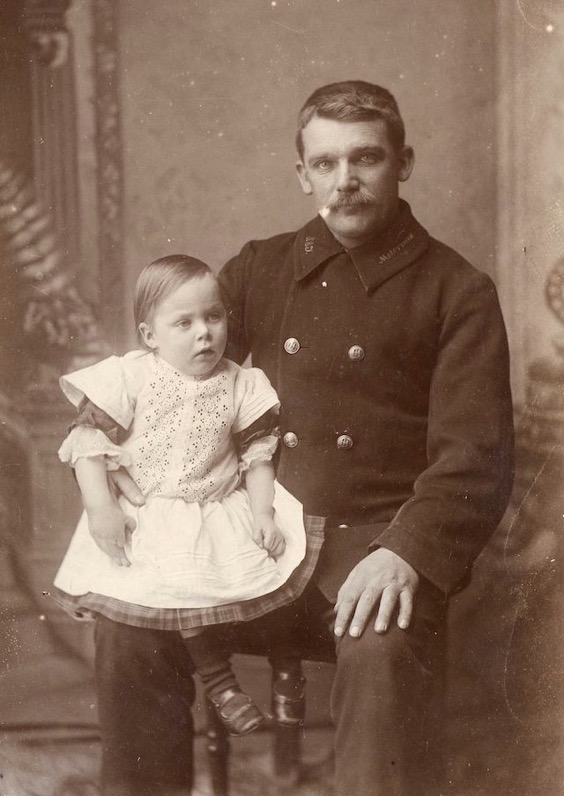
A studio portrait of a BCT motorman with his daughter (presumably) — photo undated, but probably Edwardian. Author's Collection.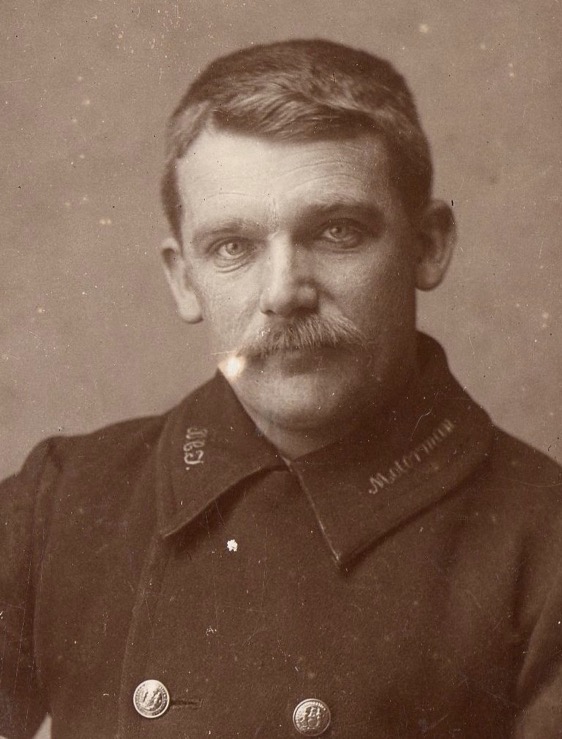
An enlargement of the above photograph showing details of the uniform. Both collars carry embroidered badges: 'Motorman' on the left-hand side and 'BCT' on the right-hand side.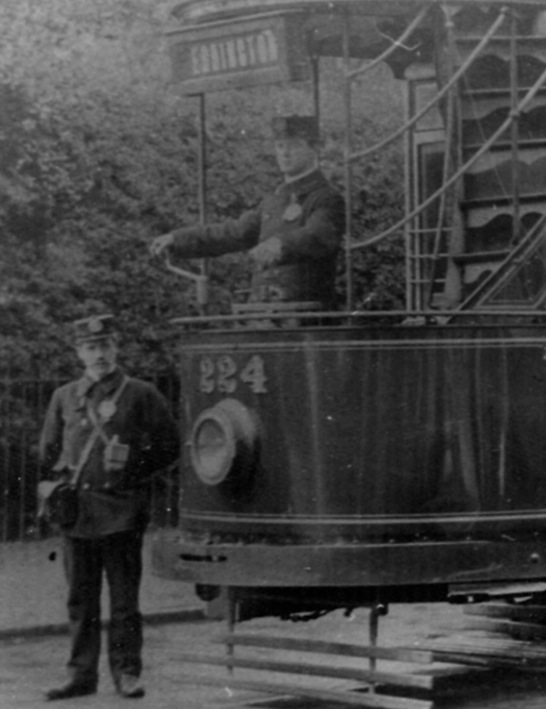
A conductor and a motorman pose with Tramcar No 224 on a service to Erdington — photo undated, but probably taken shortly after the corporation took over this route in 1907. Both men are wearing round licence badges. Photo courtesy of the Tramways and Light Railway Society, with thanks to David Voice.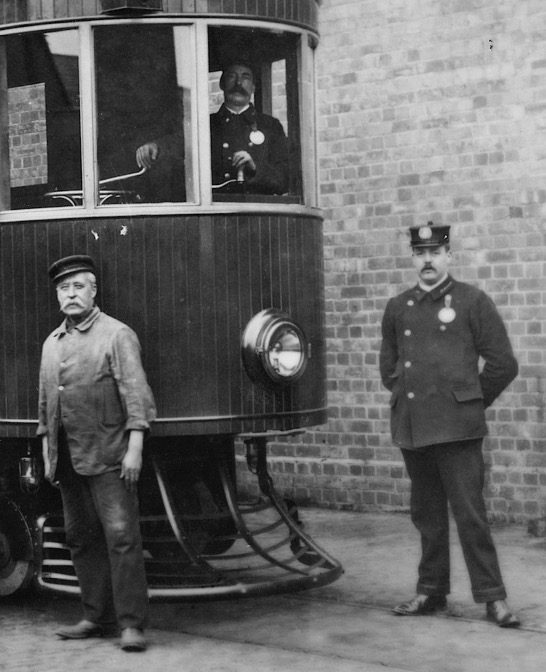
A fitter and two motormen captured in a depot yard with a grinder car — photo undated, but certainly Edwardian. Both motormen are wearing round licence badges. Author's Collection.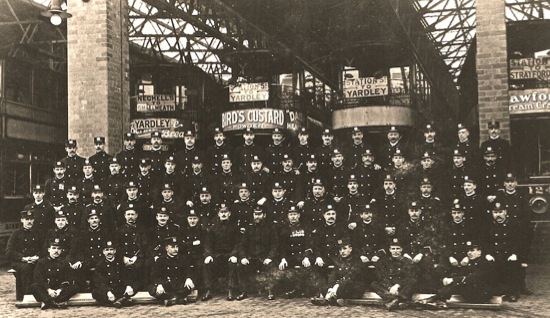
The staff of the Arthur St depot, assembled for the camera in May 1910. With thanks to Judith M. Smith and David Smith.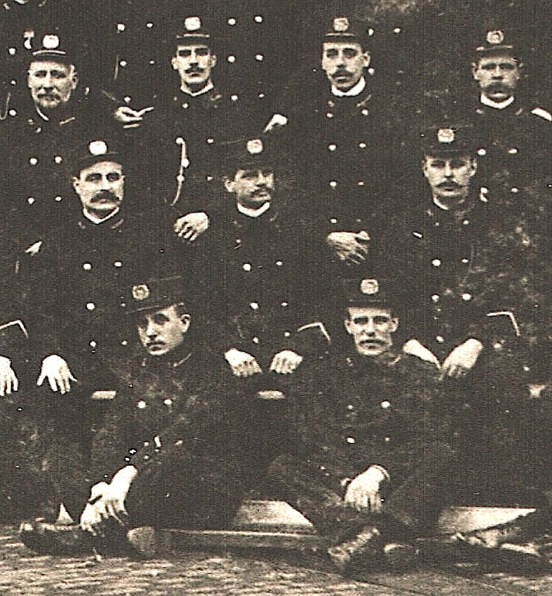
An enlargement of the above photograph showing a group of motormen and conductors. All are wearing double-breasted jackets with high fold-over collars and kepi-style caps. Several of those depicted are wearing Long Service / Good Conduct chevrons. With thanks to Judith M. Smith and David Smith.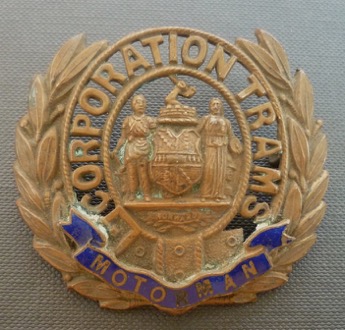
Early-period ‘MOTORMAN’ cap badge (worn from 1904 to the Great War) — brass and blue enamel. Author's Collection.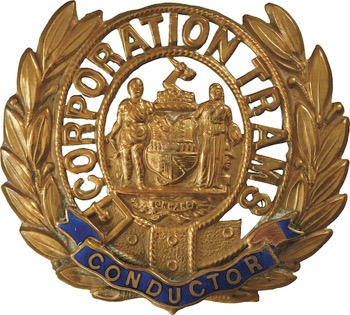
Early-period ‘CONDUCTOR’ cap badge (worn from 1904 to the Great War) — brass and blue enamel. Author's Collection.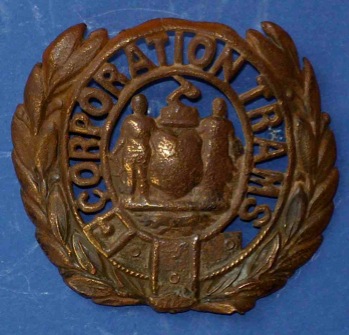
Early-period grade-less cap badge (worn from 1904 to the Great War) — brass (dug). Author's Collection.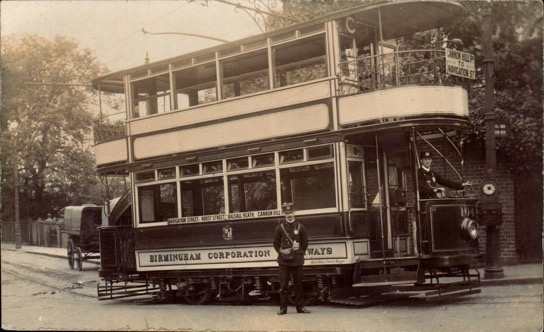
Another photograph that is thought to have been taken around 1910, this time of Tramcar No 104 at what is possibly Cannon Hill Park. Photo courtesy of Duncan Holden.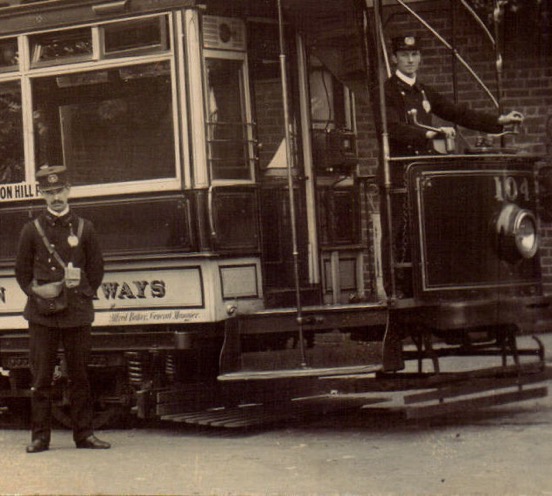
An enlargement of the above photograph showing the conductor and the motorman. Both are wearing the standard double-breasted jacket and kepi-style cap, along with a round licence badge.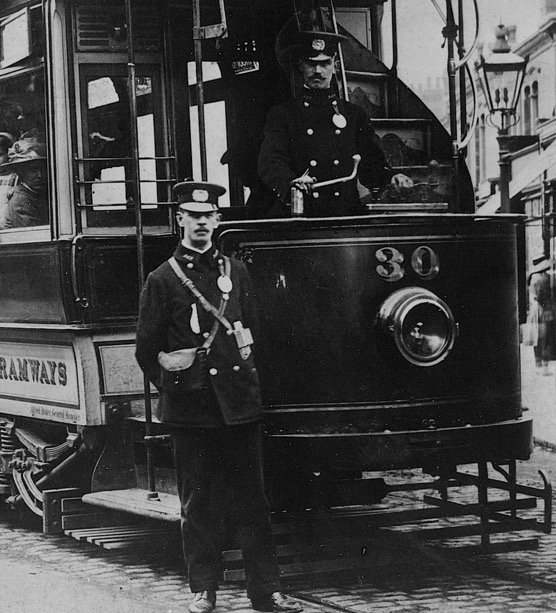
A conductor and a motorman pose with Tramcar No 30 at what appears to be the Bearwood terminus (junction of Hagley Rd and Beech Lane) — photo undated, but given the tensioned-crown peaked caps, probably taken between c1911 and 1914. The round licences were clearly still be worn at this time. Photo courtesy of the National Tramway Museum. With thanks to David Smith for identifying the location.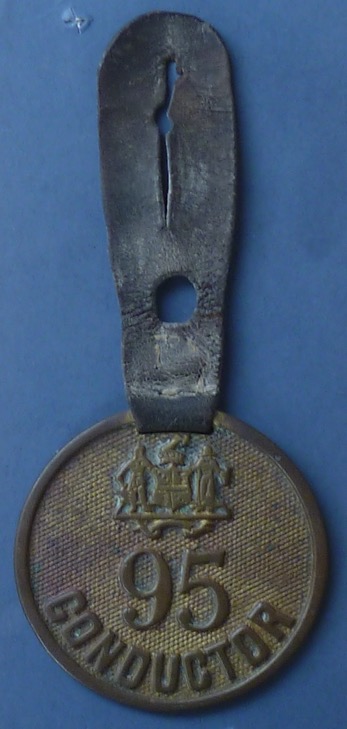
Birmingham municipal ‘CONDUCTOR’ licence badge. This is probably the pattern of licence badge issued to all conductors working electric services within Birmingham — including companies and the corporation — from the early Edwardian era through to the Great War. Author's Collection.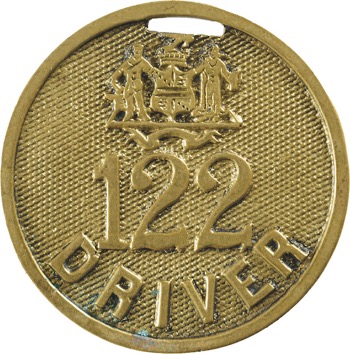
Birmingham municipal ‘DRIVER’ licence badge. This is probably the pattern of licence badge issued to all motormen working electric services within Birmingham — including companies and the corporation — from the early Edwardian era through to the Great War. Author's Collection.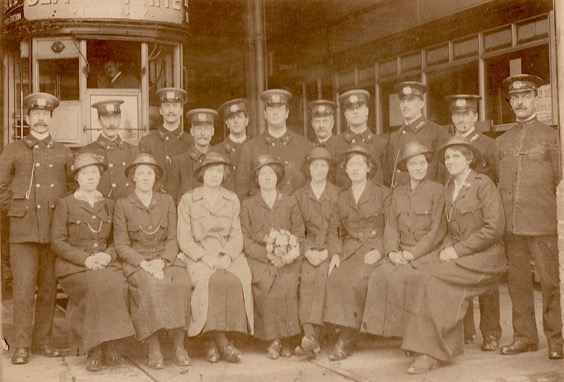
A depot shot of a group of BCT tramwaymen and women — photo undated, but almost certainly taken during the Great War. Author's Collection.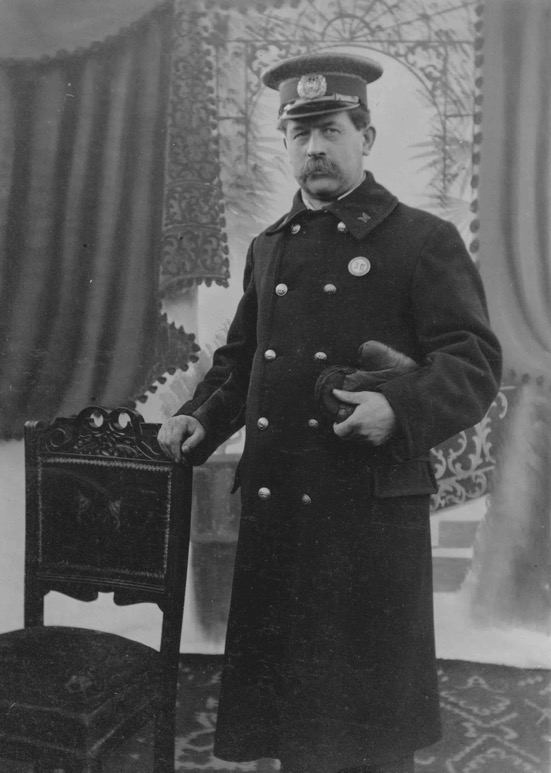
A studio portrait of a BCT motorman, possibly a Mr J R Werring — photo undated, but probably taken around the time of the Great War. Author's Collection.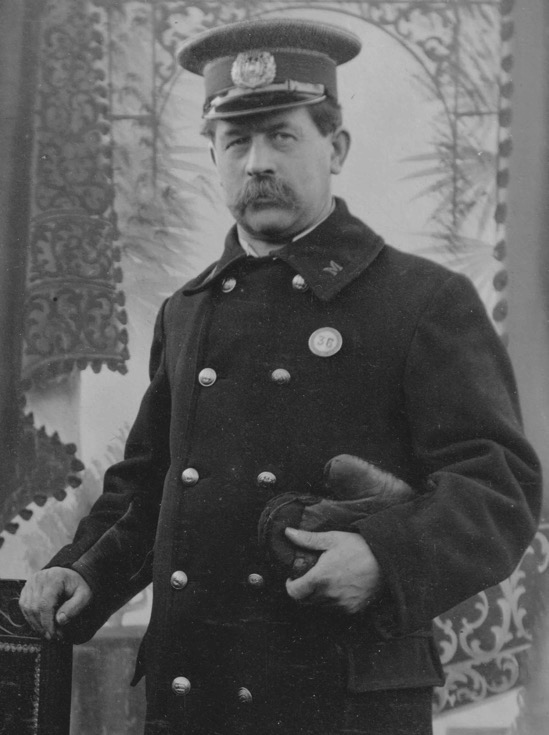
An enlargement of the above photograph showing details of the greatcoat insignia, including the grade designation ('M') on the collar. The purpose of the round badge on the subject's left breast is unclear, as it is not seen in any other surviving photograph. 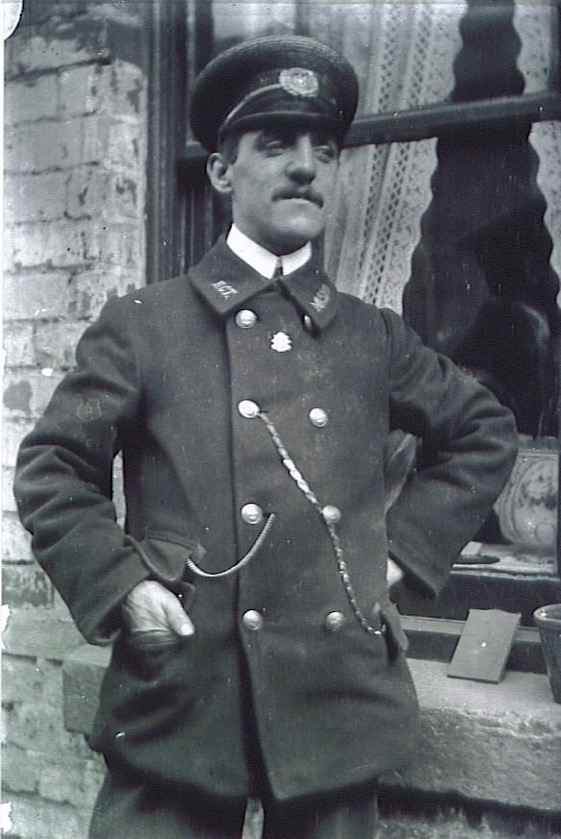
Motorman Henry James Baker in early pattern uniform — undated, but probably taken during the Great War. Motorman Baker was born on 8th May 1890 in Aston, was living in Winson Green by his early twenties, and finally emigrated to Australia (on the Steam Ship Eurypides) in April 1921. The 'B C T' initials on the collar would appear to be embroidered, in contrast to the employee number on the opposite collar which would appear to be brass. With thanks to the Henry James Baker Collection. 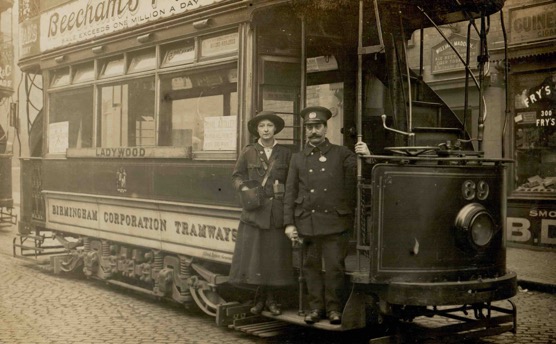
The crew of Tramcar No 69, on a service to Ladywood, pose for the cameraman during the Great War (c1917). The motorman is James Ashton, who was born in 1874 in Juniper Hill, Cottesford, Oxfordshire. He was living in Edgbaston when he married in 1889, and was still resident at the same house when he died in 1946. He worked for Birmingham Corporation for at least 35 years, though not all of it on the trams. Photo with kind permission of James' great grandson, Rob Frost.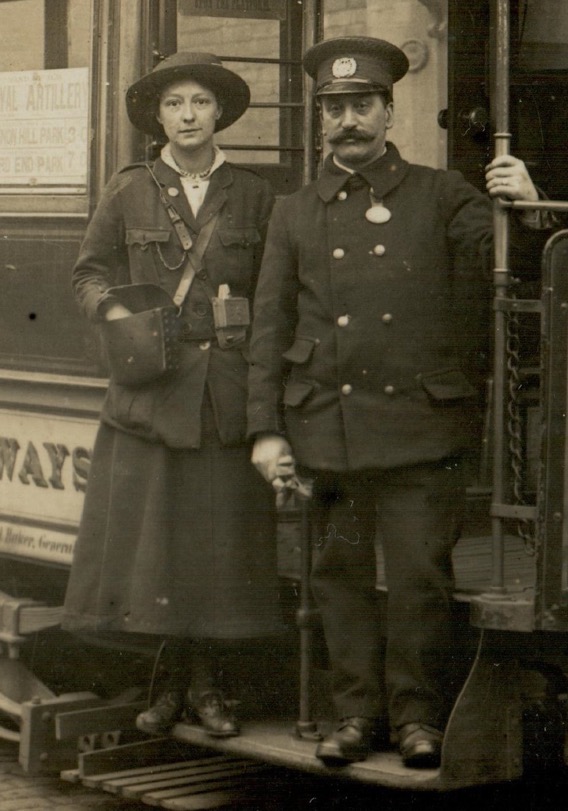
An enlargement of the above photograph showing Motorman Ashton and his conductress. His jacket collars are plain, i.e., without the usual grade and employee number. The nature of the oval badge suspended from his top jacket button is also unclear. It is too small to have been an oval licence badge, though just about the right size for the oval cap badges that were introduced around this time.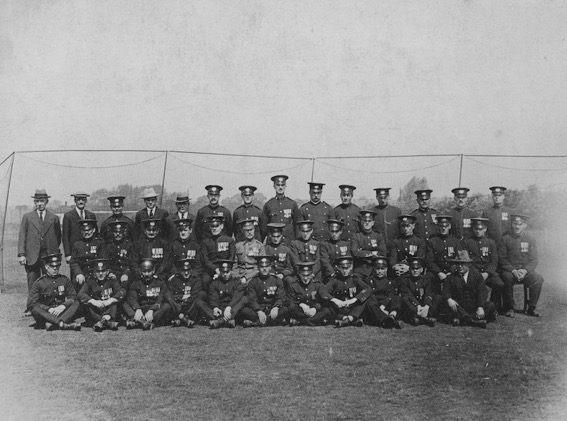
A commemorative staff photo, which judging by the large number of Great War medals on show, was probably taken around 1920/21. Author's Collection.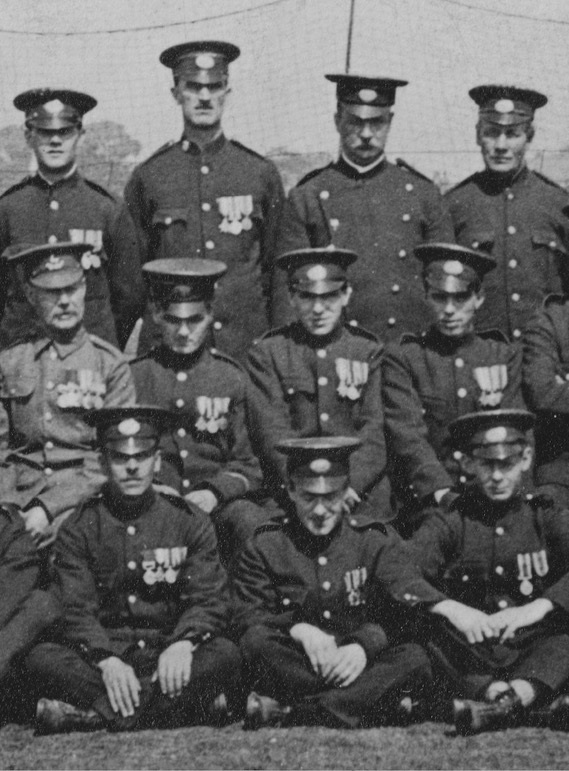
An enlargement of the above photograph showing eleven of the men, ten in single-breasted jackets, one in a lancer-style tunic and one in a military jacket. All bar the soldier are wearing the new pattern oval cap badge.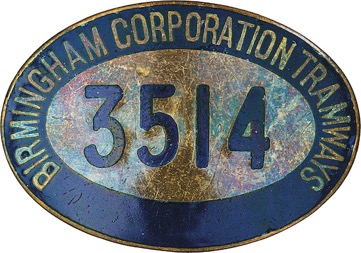
Later-period brass and blue enamel cap badge, worn by both motormen and conductors from around the end of the Great War through to closure. Author's Collection.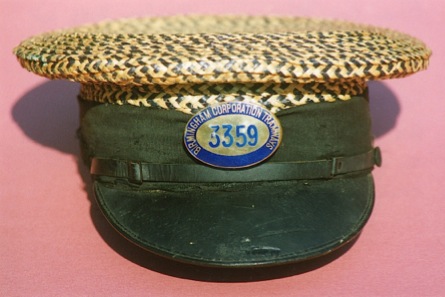
Birmingham Corporation Tramways straw-topped cap. With thanks to Judith M. Smith and David Smith.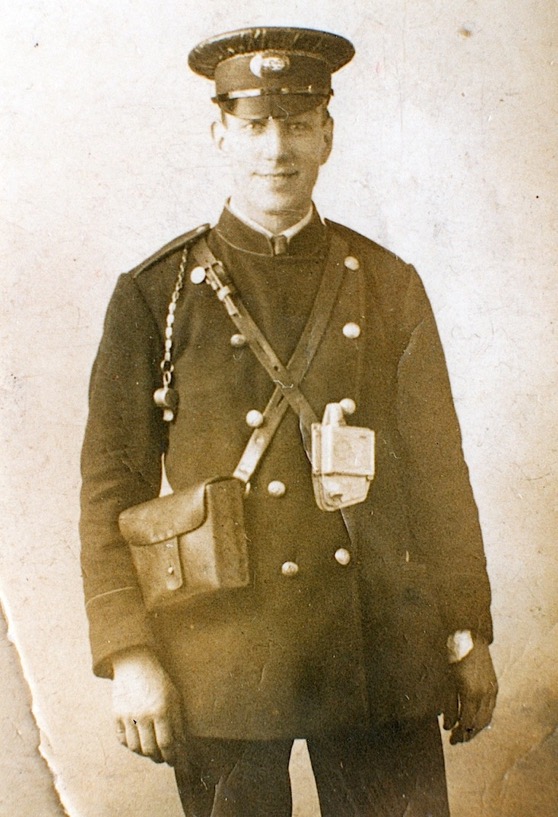
An unknown BCT conductor — photo dated January 1920. With thanks to Judith M. Smith and David Smith.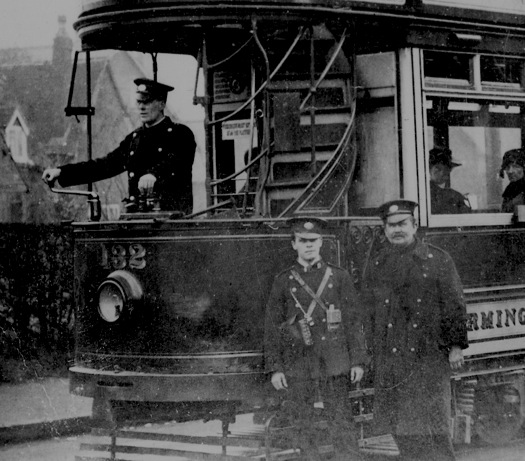
A motorman and two conductors with Tramcar No 132 at the Acocks Green terminus in 1920. All present are wearing the new oval cap badge. Author's Collection.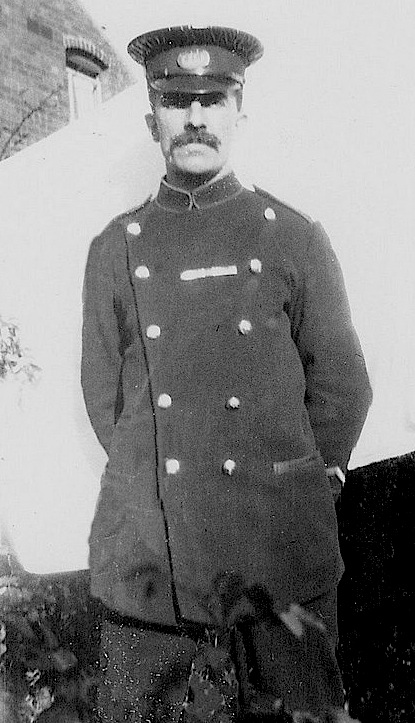
Motorman Arthur Baker (born 1886), probably taken some time in the early to mid-1920s. Motorman Baker started his BCT career in 1907, and in this photo, clearly sports his Great War medal ribbon. The cap badge is the newer oval brass and blue enamel design. Note the Long Service Good Conduct chevron on his left sleeve. With thanks to his grandson, Colin Baker.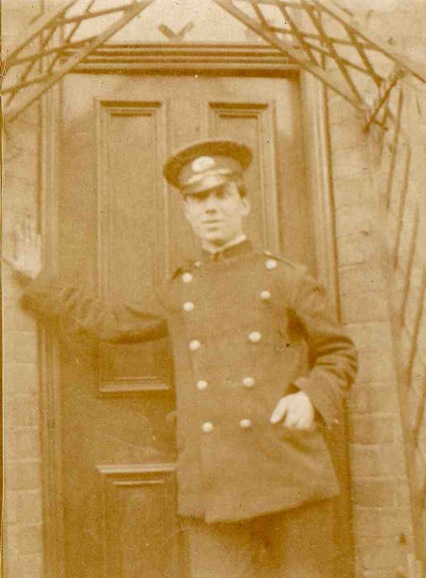
Albert Baugh, who was probably born in 1898, and later became an inspector, shown sometime around 1926/27. 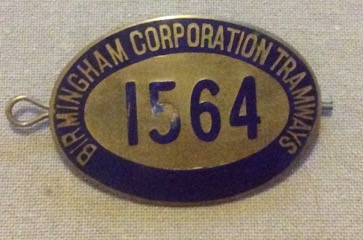
Albert Baugh's cap badge — 1564 — courtesy of Tony Schuck.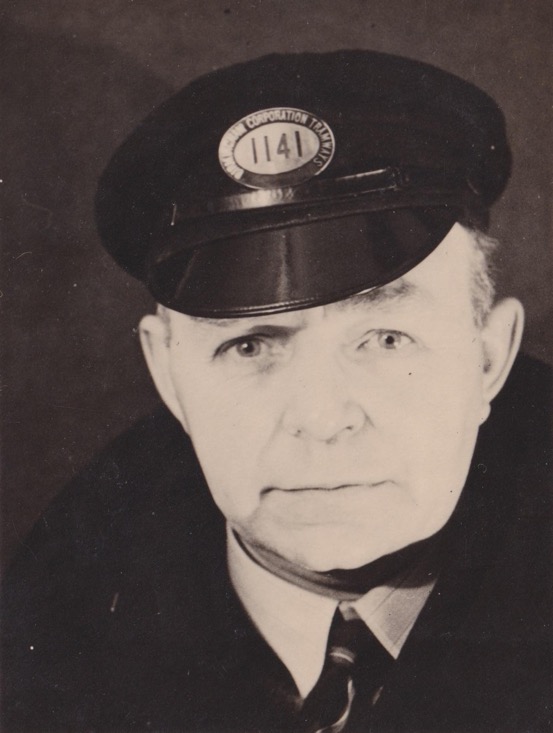
BCT employee No 1141 — photo undated but probably taken in the 1930s or 1940s. Author's Collection.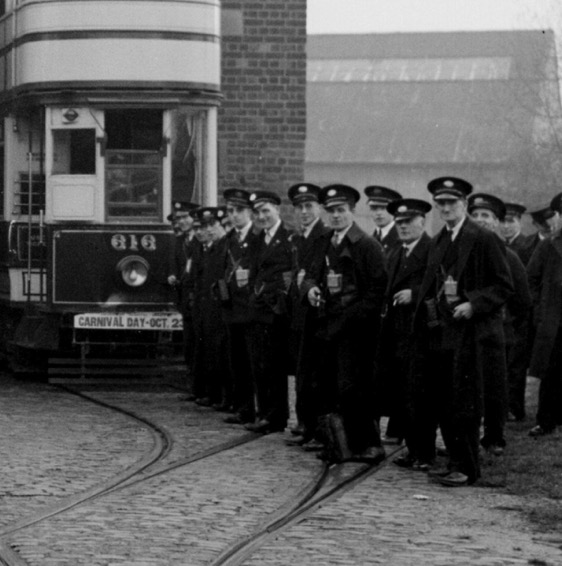
A large group of tramcar staff waiting with their cars at Handsworth Depot (closed since 1924, but still used for parking up Football Specials like these) — photo undated, but probably taken on Saturday 23rd October 1937. Photo by W A Camwell, courtesy of the National Tramway Museum. With thanks to David Smith for background information.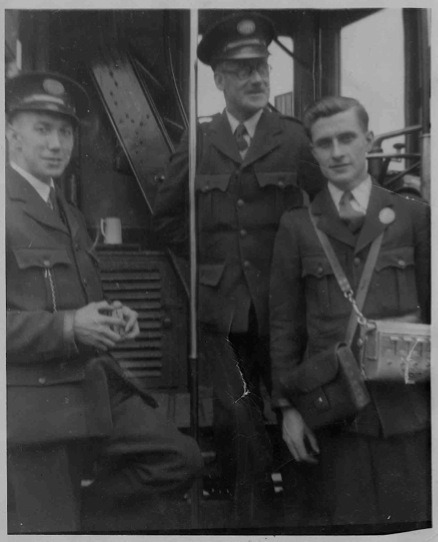
Motorman Frank Bridges (No 3359), Motorman Fred Girling (No 3270) and Conductor Pat Kavanagh in July 1951, all wearing single-breasted jackets with lapels. The two motormen are wearing the later-period blue enamel cap badge, despite the name of the organisation having changed to Birmingham City Transport some 14 years earlier. The conductor is wearing a round badge (on his cash-bag strap), which may possibly be of the type shown below, though this is far from certain. I am indebted to David Smith for the background information to this photograph.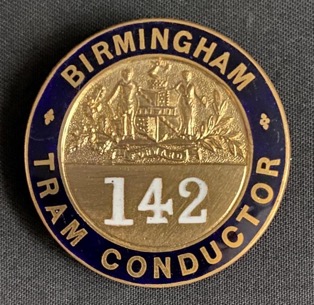
Birmingham Corporation numbered 'TRAM CONDUCTOR' badge, brass with deep-blue enamel inlay. It is unclear when these badges were worn, as no clear photographs of them in use are known. Photo courtesy of the Stephen Howarth Collection.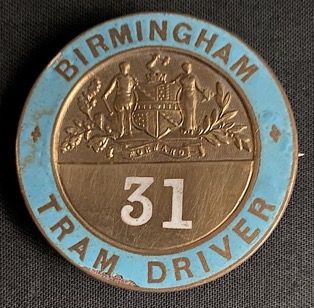
Birmingham Corporation numbered 'TRAM DRIVER' badge, brass with light-blue enamel inlay. It is unclear when these badges were worn, as no clear photographs of them in use are known. Photo courtesy of the Stephen Howarth Collection.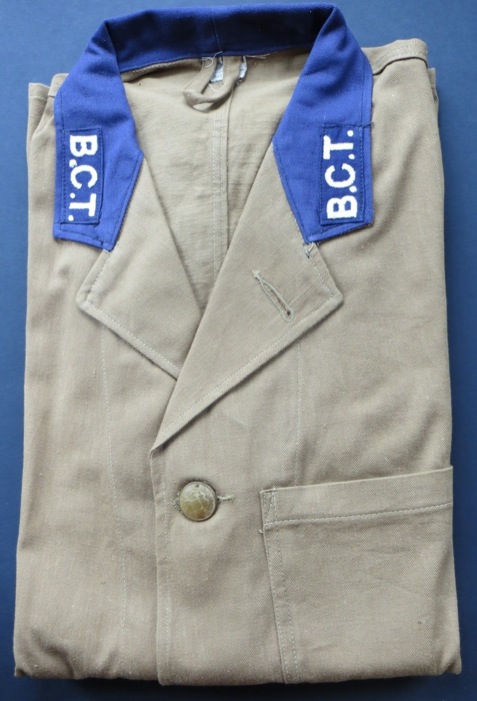
Birmingham City Transport summer dust jacket with natural horn buttons — this particular example bears the date 1942. With thanks to Judith M. Smith and David Smith.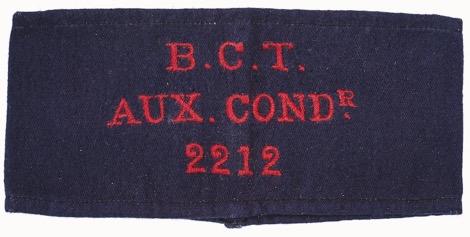
Birmingham City Transport auxiliary conductor's armband. These were worn by members of the public who helped on the darkened and overcrowded trams during the Second World War. Author's Collection.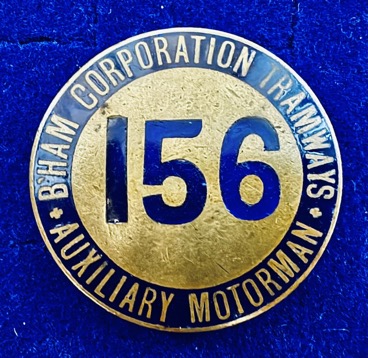
Birmingham Corporation Tramways Auxiliary Motorman badge No 156 – brass with deep-blue enamel inlay. The pin-back fixing presumably allowed it to be affixed to the jackets of non-uniformed staff, most likely depot staff who were filling in when no motorman was available. Author's Collection.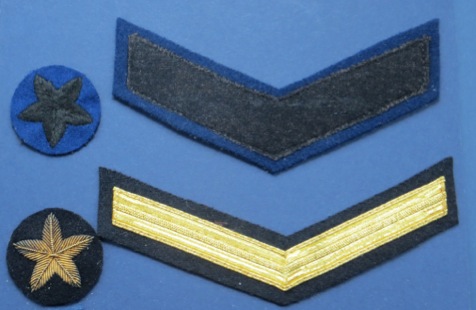
Birmingham City Transport Long Service / Good Conduct badges. The chevrons were for 3 years and the star was added after 10 years; gold for tunics/jackets and blue for the overcoats. With thanks to Judith M. Smith and David Smith.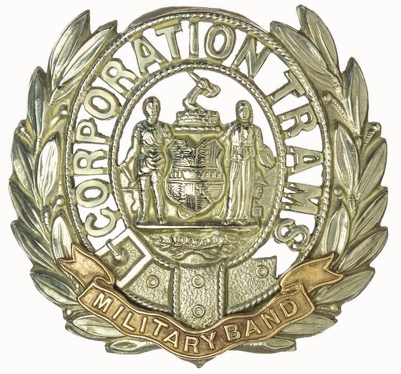
Birmingham Corporation Tramways Military Band cap badge, nickel and brass. This badge appears to be as manufactured, the brass being smooth, i.e., without the stippling that would have been necessary (as a key) had it been inlaid with enamel. Author's Collection.
Senior staff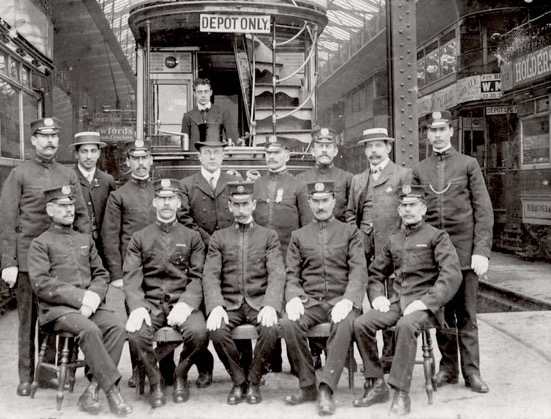
A group of nine BCT inspectors and a district inspector — photo dated May 1908. Author's Collection.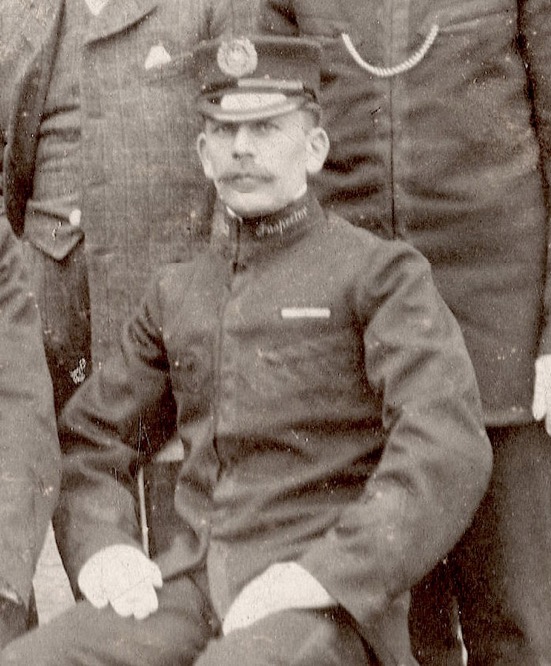
A blow-up of the above photo showing one of the inspectors. His grade is easily made out on his collar, as are the sleeve chevrons and the prominent cap badge.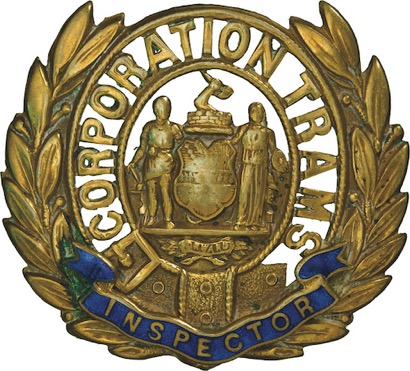
Birmingham City Tramways inspector's cap badge — brass. This style of badge was probably issued from 1904, and at some point was probably superseded by a nickel version. Author's Collection.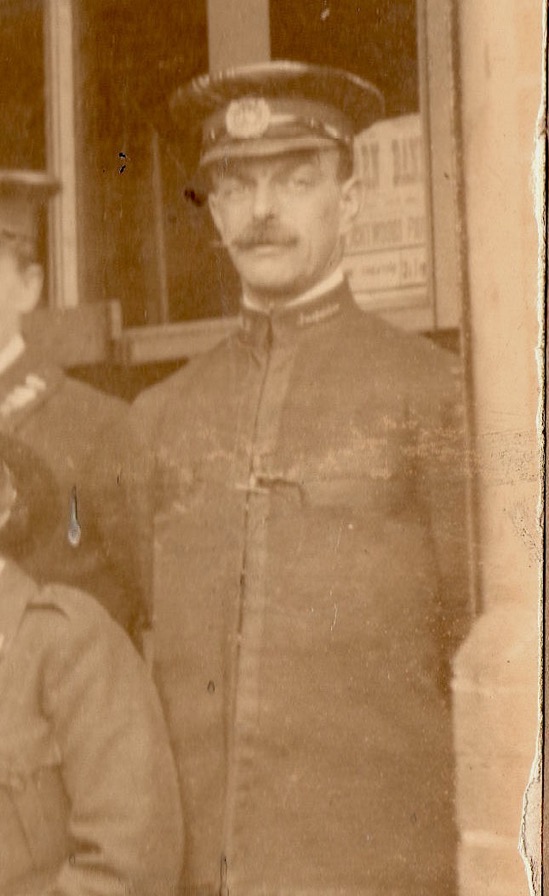
An enlargement of the Great War depot photograph above, showing an inspector.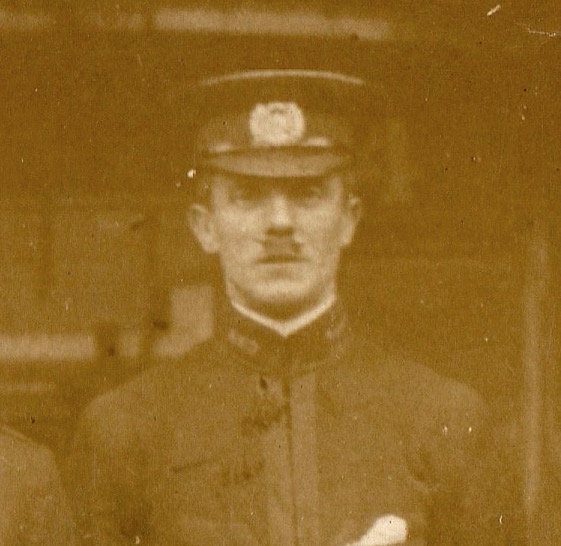
An enlargement of a Great War conductress group photograph (see below) showing an inspector. Both collars carry embroidered designations, 'Inspector' on the bearer's left-hand side and 'B C T' on the right-hand side.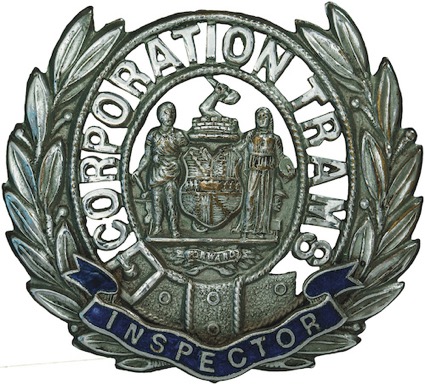
Birmingham City Tramways inspector's cap badge — nickel. This style of badge probably replaced the brass issues at an unknown date, but was itself replaced after 1927 9at least for new issues), when the name of the department was changed. Author's Collection.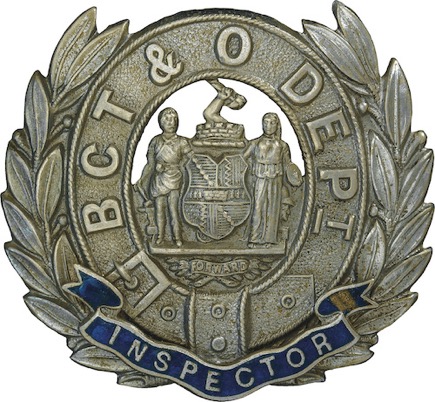
Birmingham Corporation Tramways and Omnibus Department inspector's cap badge — nickel. This style of badge was probably issued between 1927 and 1937, in which latter year, the name of the department was once again changed. Author's Collection.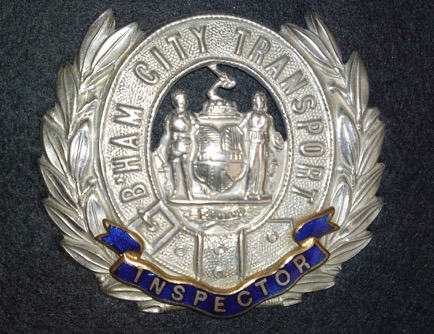
Birmingham City Transport inspector cap badge — nickel. This style of badge would have been issued from around 1937 onwards, though it was probably superseded by chrome prior to the closure of the tramway system in 1953. With thanks to Darren Lodge.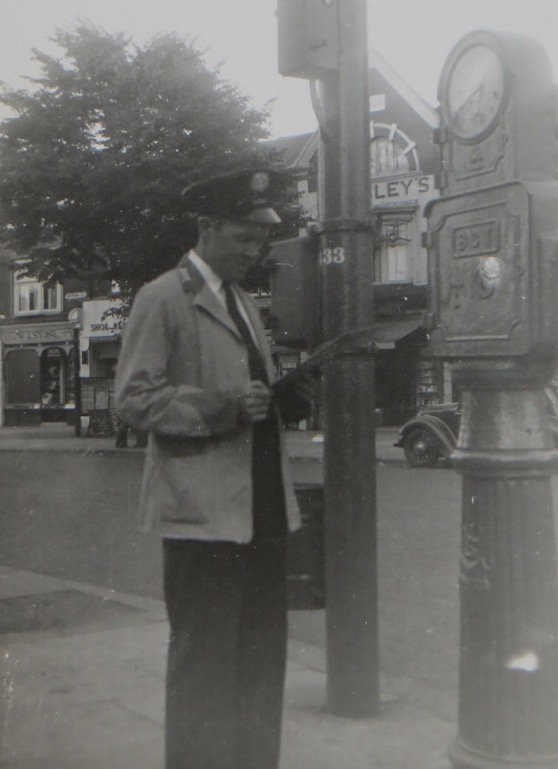
Birmingham City Transport Inspector Billy Bushell, formerly a motorman, at No 2 Erdington tram terminus in a summer dust jacket — 1950. With thanks to Judith and David Smith.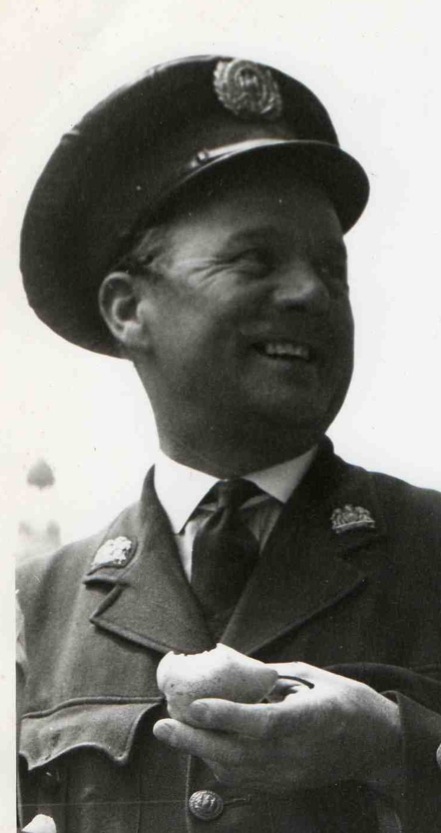
Birmingham City Transport Inspector Billy Bushell once again, this time in Colmore Rd on 27th May 1957, sampling some Australian fruit. Although this was after the demise of the tramway, it does show details of the later-period inspector uniform and cap badge, which was by this time presumably a 'Birmingham City Transport' issue, though clearly very similar in form to the older style ’tramway’ cap badges. Photo taken by the Birmingham Post and Mail. With thanks to David Smith for the correct identification.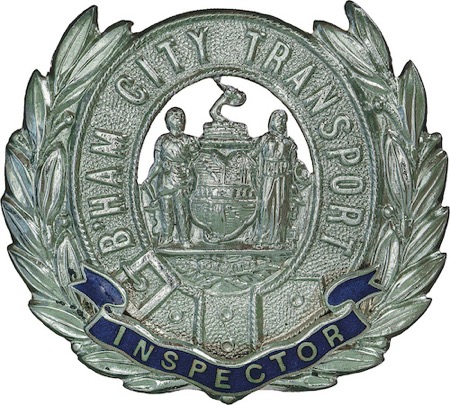
Birmingham City Transport inspector cap badge — chrome. This style of badge was probably issued to new inspectors late in the tramway's life. Author's Collection.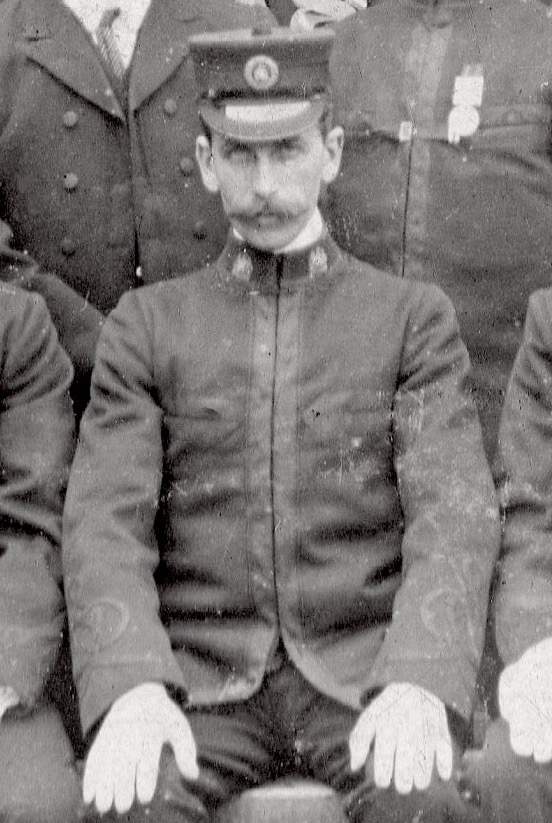
Another enlargement of the staff photo above, this time showing the district inspector, who is probably Mr R Hamer of the Northern Section (see below). His collar and cap insignia are probably cloth with gold bullion thread, a type of badge that was definitely used for senior grades in later years.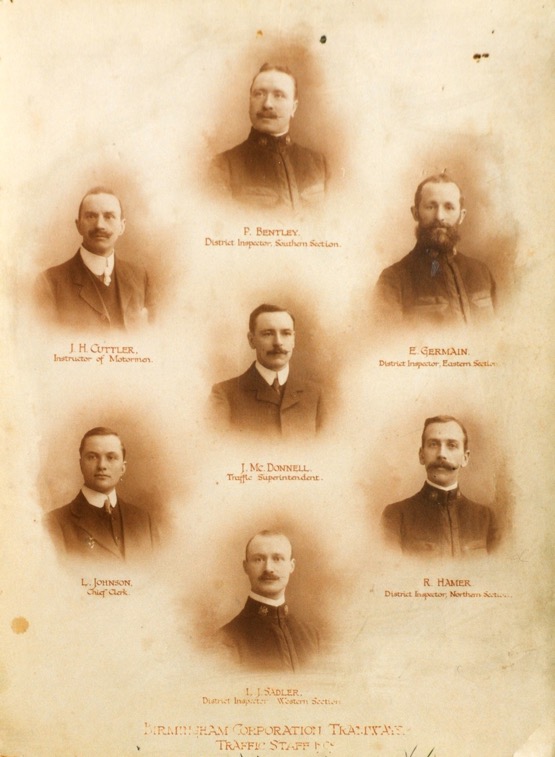
Birmingham Corporation Tramways Traffic Staff 1909. Centre, J McDonnell (Traffic Superintendent); top, P Bentley (District Inspector — Southern); clockwise, E Germain (DI — Eastern); R Hamer (DI — Northern); L J Sadler (DI — Western); L Johnson (Chief Clerk); J H Cuttler (Inspector of Motormen). Sixteen years on from this photo, J H Cuttler shot his boss (L Johnson) in his office — Johnson apparently survived and Cutler was eventually acquitted of a murder charge! With thanks to Judith and David Smith for the photo and the background information.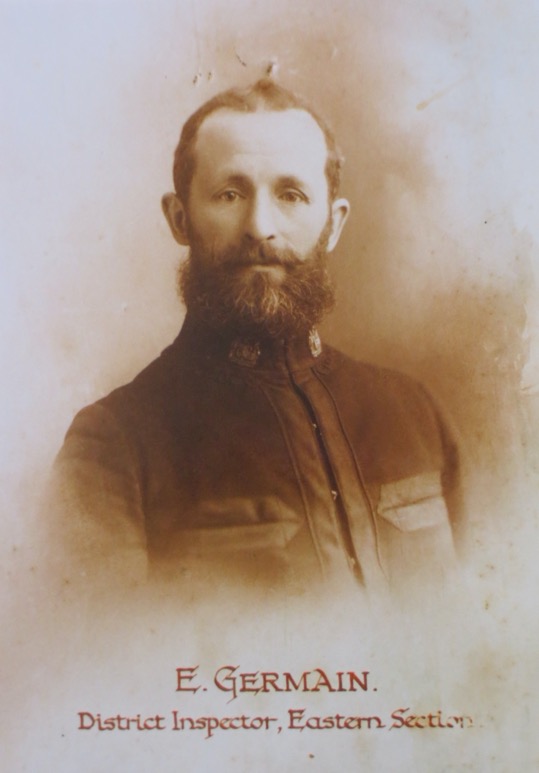
Birmingham Corporation Tramways District Inspector Germain — photo taken in 1909. With thanks to Judith and David Smith.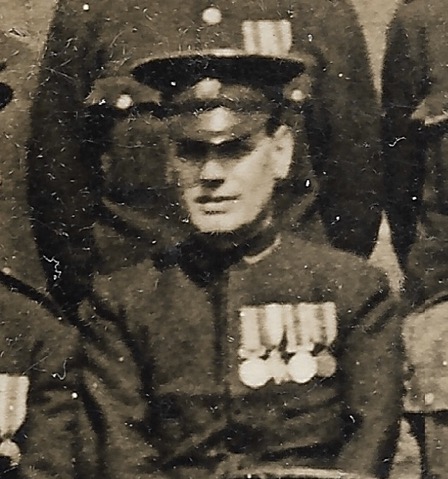
A blow-up of the 'Great War medals' photo above showing a senior grade inspector. Unlike the large brass/nickel pattern of cap badge issued to inspectors, his cap bears a much smaller badge, very probably of embroidered cloth and bullion wire.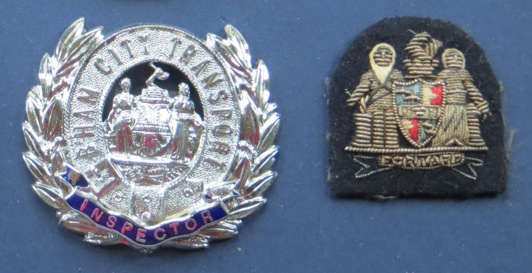
Birmingham City Transport inspector's cap and collar badges as worn by Bert Smith — chrome. With thanks to his son, David Smith.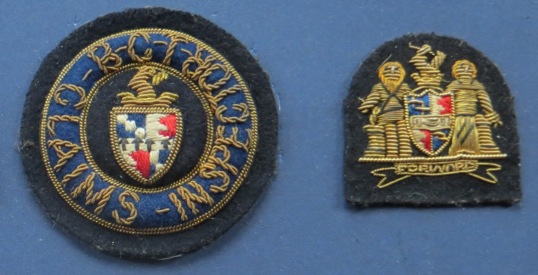
Birmingham City Transport claims inspector's cap and collar badges as worn by Bert Smith — gold bullion. With thanks to his son, David Smith.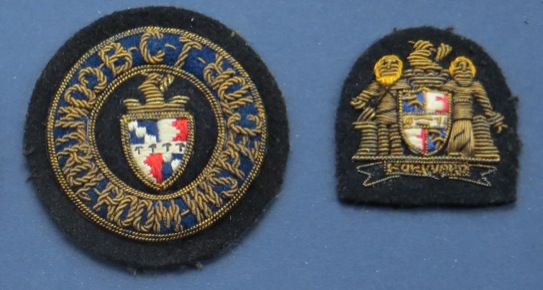
Birmingham City Transport control room inspector's cap and collar badges — gold bullion. With thanks to David Smith.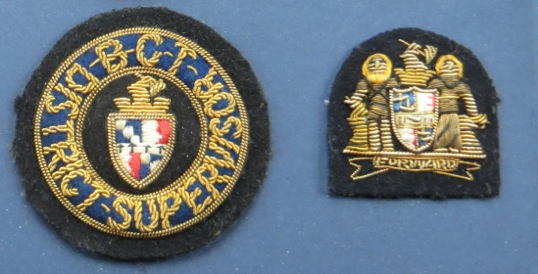
Birmingham City Transport district supervisor's cap and collar badges, as worn by Mr George Cross, a superintendent at Miller St depot — gold bullion. With thanks to David Smith.
Female staff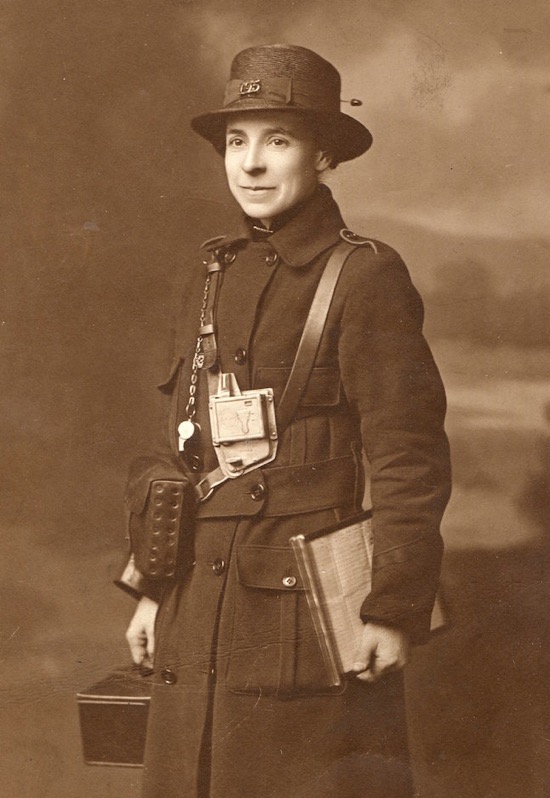
A superb studio portrait of a BCT Great War conductress with all her paraphernalia. Author's Collection.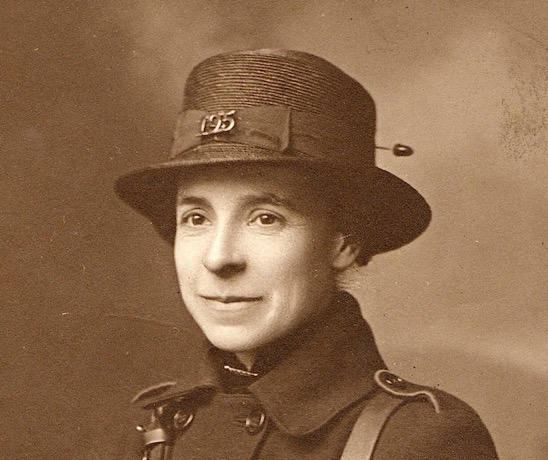
An enlargement of the above photograph, which reveals the subject to be Employee No 195. Although her greatcoat is tailored with piped epaulettes, the buttons are plain and the collars are without badges of any kind.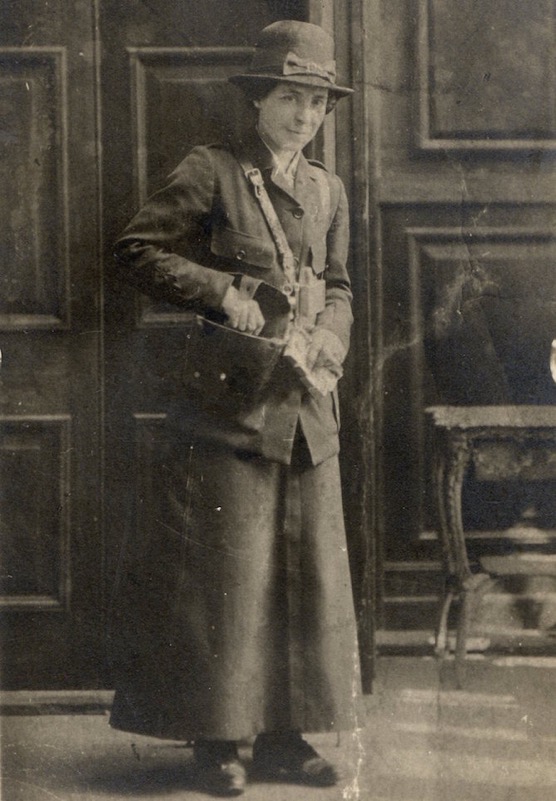
Another portrait of the same conductress (Employee No 195) — photo undated, but probably taken relatively early in the Great War. This shot shows the subject in her uniform jacket rather than greatcoat, which is once again unmarked and with plain buttons. Author's Collection.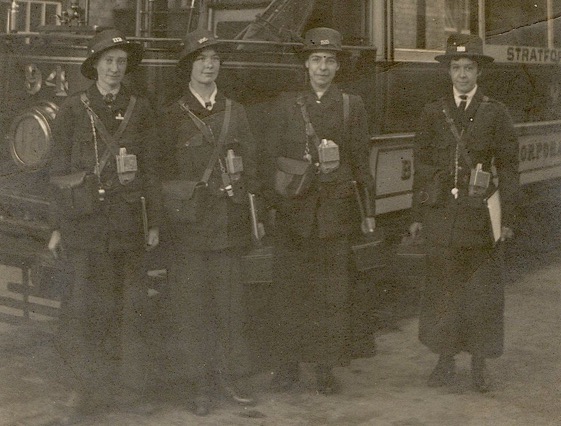
A depot shot of four Great War BCT tram conductresses, from left to right: Employees 112, 105, 195 (the lady above) and 101. The tramcar in the background is No 94, which bears a Hall Green to Station St destination board (on the top deck) and a Stratford Rd route board on the side. Author's Collection.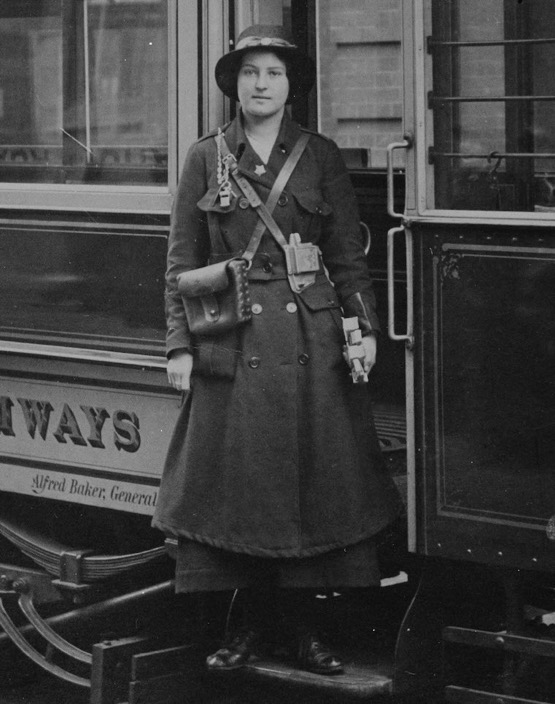
BCT Great War conductress on the platform step of Tramcar No 8 — photo undated. The badge on her lapel — and maybe the one on her bonnet too — is probably a regimental sweetheart badge. Photo courtesy of the National Tramway Museum.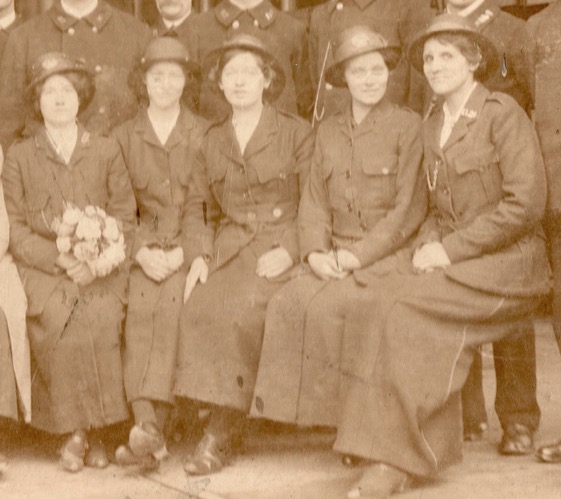
An enlargement of the Great War depot photograph shown above. Whilst the ladies depicted are wearing the straw bonnets seen in the preceding photos, these clearly bear the standard wreath cap badge rather than an employee number. 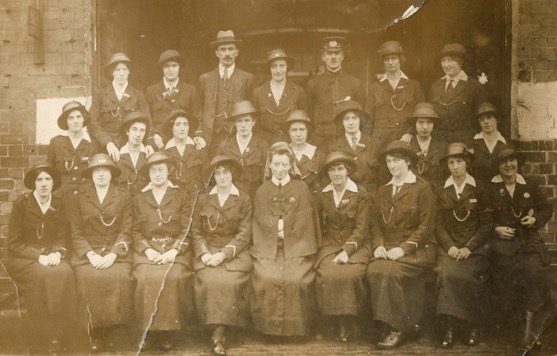
A group of BCT Great War conductresses. Given that the vehicle in the background is a bus, and the sign at the top left contains the word 'bus', the ladies depicted are very probably bus conductresses. The rear of the photograph is marked 'THE "HIGHBURY" STUDIO, 48 Bristol Street, Birmingham. Proprietors — H. Hitchinson, M. A. Mason'.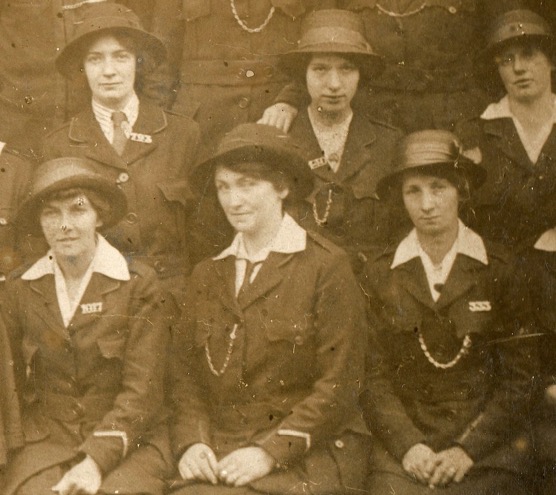
An enlargement of the above photograph showing details of the ladies' uniforms; in contrast to the photos above, the employee number is borne on the jacket lapel rather than the hat.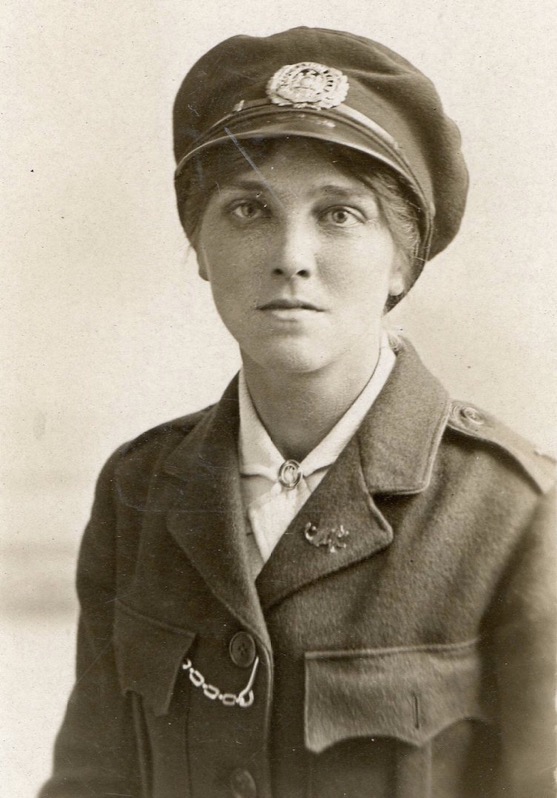
BCT female employee — photo undated, but almost certainly taken during the Great War. Although the uniform jacket is identical to that seen in previous photos, the headgear now takes the form of a baggy motor cap with the standard wreath cap badge. Author's Collection.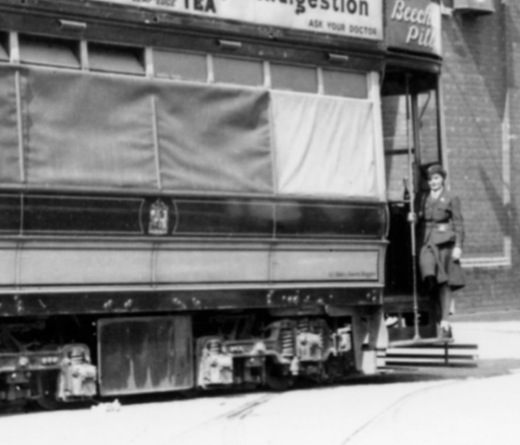
A war-time (WW2) shot of Tramcar No 2 on the Number 6 route to Perry Barr. The conductress is wearing a tailored jacket and skirt, along with what appears to be a baggy field cap. Photo courtesy of the Tramways and Light Railway Society, with particular thanks to David Voice.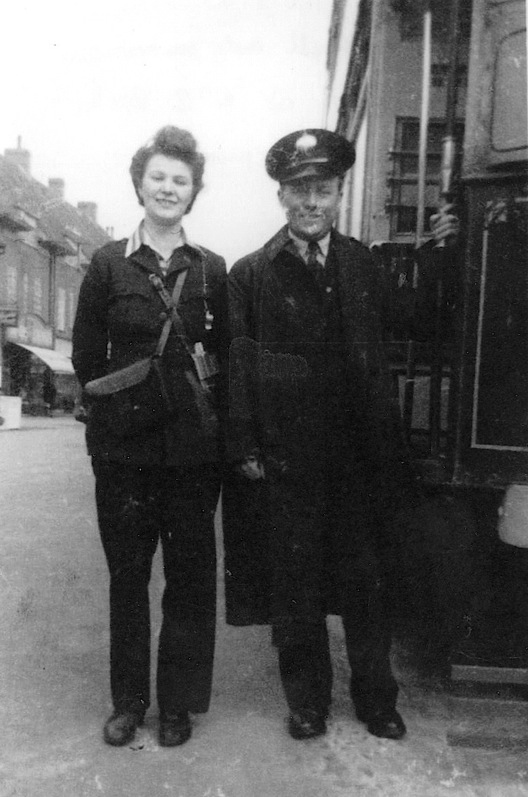
Birmingham City Transport conductress and Motorman Billy Bushell at Erdington Terminus on the No 2 route — photo undated, but almost certainly taken in the 1940s. With thanks to Judith and David Smith.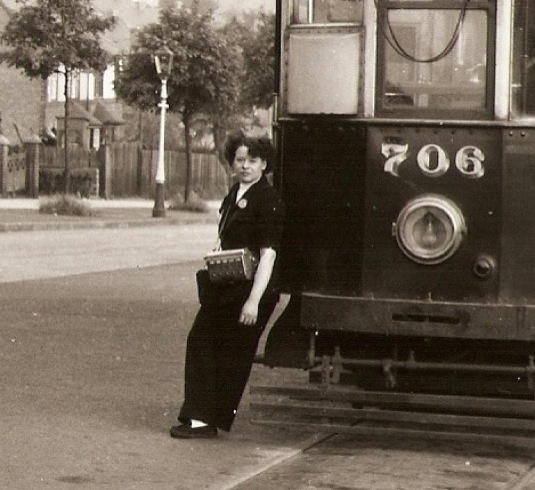
Birmingham City Transport conductress V Caine uses Tramcar No 706 as a convenient prop — photo taken at the Short Heath terminus (Route No 1) circa 1950. With thanks to Judith and David Smith.